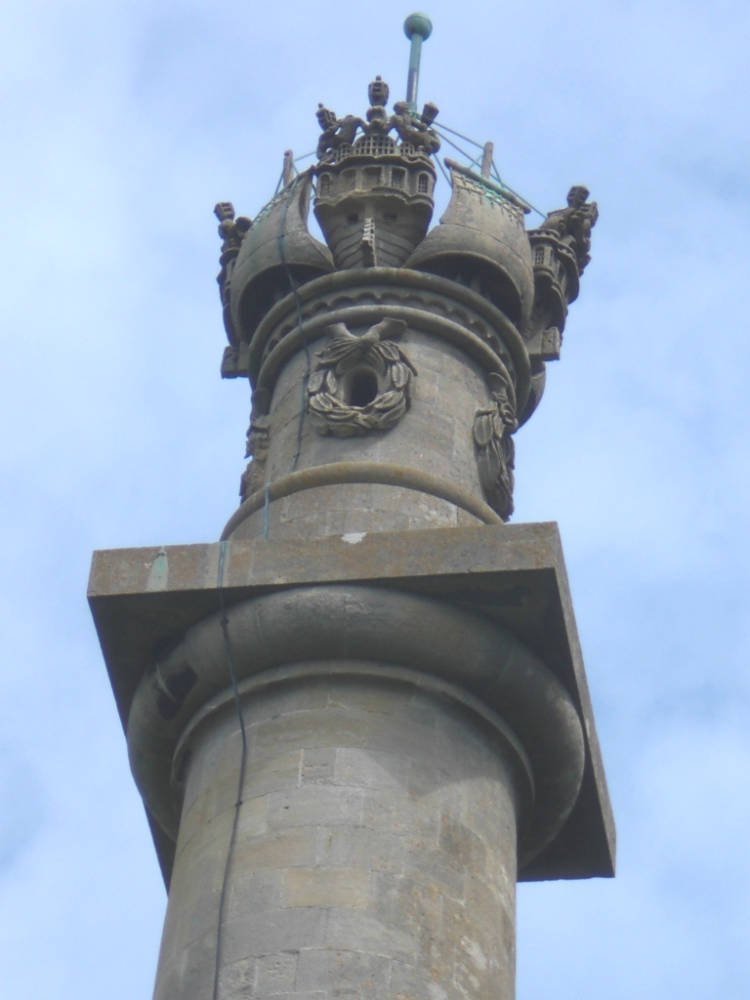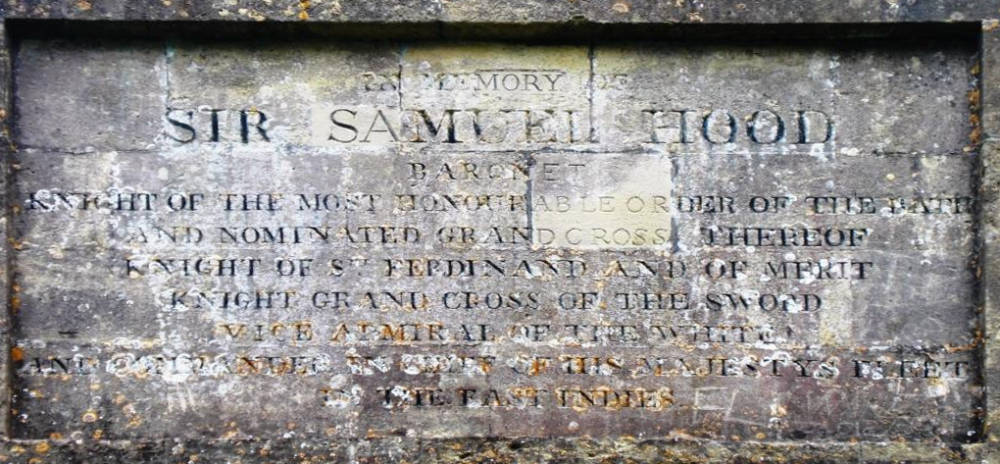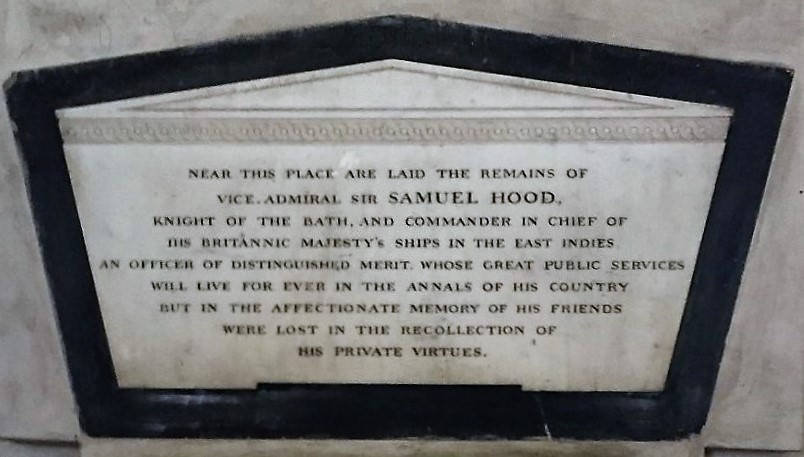The photographs are by the author except for the plaque in St Mary's Church Madras which is” by WestCoastMusketeer (Own work) [CC by-SA 4.0 (http://creativecommons.org/licenses/by-sa/4.0)], via Wikimedia Commons.


On a hill near the village of Compton Dundon in Somerset stands an impressive 110 foot column, erected in 1831, to Admiral Sir Samuel Hood (1762-1814) one of Britain’s naval heroes of the Napoleonic era. The local government website describes it drily as a “Commemorative monument. Early C19th. Ham stone. In form of Doric column on almost cuboid ashlar base set on two tall steps, the lower supporting a wrought iron railing enclosure; above column a dome/crown featuring sails and sterns of men-o'-war.”
The architect was Henry Edmund Goodridge. Goodridge (1797-1864) was born in Bath and pursued his career in that city. Among his many works was the Corridor Shopping Arcade in Bath and Beckford’s Tower at Lansdown overlooking the city, commissioned by William Beckford. Beckford was a Jamaica plantation owner, novelist, art collector and politician who had just sold his monumental folly at Fonthill Abbey. He and Goodridge would work closely together. Later Goodridge took part in the competition to design the new Houses of Parliament and assisted with Isambard Kingdom Brunel on the Great Western Railway.
During a forty-five year period his architecture progressed from Regency Greek Revival, through late Georgian Picturesque towards Victorian Eclecticism (Frost; p.7) but his reputation perhaps suffered because of his close association with Beckford. Some thought of him as a jobbing local architect but Amy Frost argues that “the stylistic development of the architecture of Goodridge shows, [that] he was continually at the heart, and frequently at the forefront, of national architectural debate (p.264).

The inscription on the south face of Hood’s column base reads
This monument is dedicated to the late Commander” by the attachment and reverence of British officers of whom many were his admiring followers in these awful scenes of war in which while they call forth the grandest qualities of human nature in him likewise gave occasion for the exercise of its most amiable virtues He died at Madras, December 24th 1814.”
Almost visible from the base of the monument is the Rectory of Butleigh the village in which Sir Samuel’s distinguished naval relatives were brought up as children of the local vicar. Originally there is said to have been a mile-long avenue of cedars connecting the monument to the family seat. Curiously, however, Admiral Sir Samuel Hood was not from the Butleigh Hoods but from their cousins who came from Kingsland House at Netherbury in Dorset. Indeed there were at least 6 famous Hoods in the Royal Navy resulting in some confusion. For example there is still some debate about which Hood gave his name to the famous battle-cruiser which sank with almost all hands during an action with the German battleship Bismarck in 1941.
Born in 1760 Samuel joined the Royal Navy in 1776. He was present at the battle off Ushant aboard the Courageux in 1778, and, soon afterwards transferred to the Barfleurunder the command of his cousin Sir Samuel Hood, and took part in most of Admiral Rodney’s actions which concluded with the Battle of the Saintes in April, 1782. In 1797 he was given command of the 74 gun Zealous in which he played a heroic role in Nelson’s famous victory at the Battle of the Nile in 1798 capturing the French 74 gun Guerrier, which was later destroyed” by fire.
Hood served again in the West Indies and in the Baltic before losing an arm during the blockade of Rochefort in 1805 and missing the epic Battle of Trafalgar, only a month later. In 1809 he played a key role in assisting the escape of Sir John Moore’s army from Corunna. 26,000 British troops were duly rescued and Hood received the thanks of Parliament. In 1811 he was appointed vice-admiral and was in command of the fleet in the East Indies when he died at Madras, of “Seringapatam fever” (probably yellow fever) on 24th December 1814. There is a plaque to him on the walls of St Mary’s Church, Madras where he is buried.

By all accounts he was a remarkable man. He spent all but 3 years of his active career at sea and turned down desk jobs including a prestigious seat on the Board of Admiralty. He was said to be silent and reserved “to a distressing degree” (Hore p.24). He believed in constant self-improvement in such fields as languages, navigation, gunnery, and fortification. He was popular with his men and renowned for his quick thinking under pressure. He was an adept diplomat but above all remembered for his relentless pursuit of the enemy.
Further reading
Adkins, Roy and Lesley. The War for all the oceans. London; Little Brown, 2006.
Frost, Amy. From Classicist to Eclectic: The Stylistic Development of Henry Edmund Goodridge, 1797-1864. PhD thesis. University of Bath, 2009.
Hore, Captain Peter. Nelson’s Band of Brothers. Lives and Memorials. London; Pen and Sword, 2015 Pages 23-27.
Laughton, John Knox. Dictionary of National Biography volume 27.London; Macmillan, 1891.
Somerset Historic Environment Record. 51553, Created 2003.
Stewart, William. Admirals of the World. A Biographical Dictionary 1500 to the Present. p.171. London; McFarland, 2009.
The Seafaring Hoods of Netherbury. On The Dorset Page website, 2000.
Last modified 10 July 2016